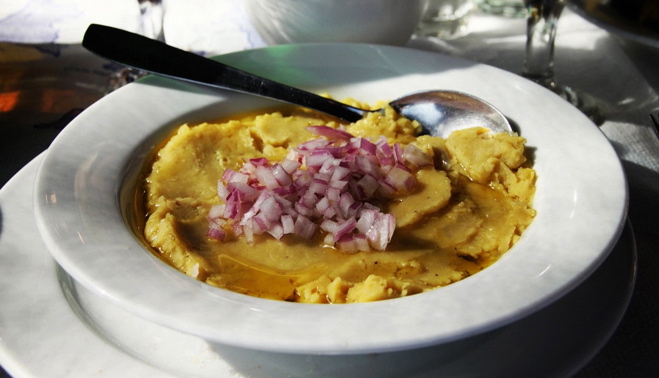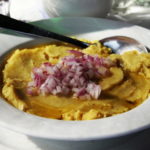Traditional Greek Santorini Fava-Yellow Split Pea Dip

As a child my mom for some reason never made fava, we ate plenty of lentil soup but not the Santorini fava dip, this yellow split pea puree. I came across it as an appetizer in tavernes (plural in Greek for taverna) here in Greece, but unfortunately modern Greeks rarely eat it at home anymore.
Once my older son began eating solid food I made sure he ate traditional, seasonal, organic Greek dishes. So when he started eating beans, I made him fava. It’s easy, tasty, and hearty, especially on a cold day.
I use the original recipe from the traditional Greek cookbook from Hrisa Paradisi. You basically boil the beans and onion, and then puree them. I used a food mill instead of a food processor to puree the beans, but you can use whatever you feel comfortable with.
I ate the fava right after I took it off the stove; it was creamy, it was warm, it was the ultimate comfort food. Of course, it’s not only soothing to eat, it is healthy. Obviously the beans are healthy, full of antioxidants and non-animal protein, but also the combination of lemon, onion, and olive oil make fava an antioxidant powerhouse.
It is thought that this dish is only an appetizer or dip but it can also be a main course.
Traditional Greek Fava-Yellow Split Pea Dip

Ingredients
- 1 pound (1/2 kg) fava These are not broad beans but yellow split peas.
- 2 whole onions chopped
- Salt and Pepper
- Olive Oil
- Lemon
- Parsley
Instructions
- Rinse the fava.
- Boil the beans together with the onions and 6-7 cups of water for about 1 ½ hour.
- Pass it through a food mill or puree sieve or a food processor.
- Put the puree in the pot again and warm up, add some salt, pepper and about ¼ cup of olive oil. Let it come to a boil for a few minutes.
- Serve with some chopped raw onion, parsley and lemon.
Photo Credit: Santorini Fava Purée by Klearchos Kapoutsis

I have used and loved a version of this that has onions, garlic, cumin and bay leaf, finished with lots of lemon juice – it is amazing. I will try this one too and see which one I like better. Thanks!
Hi Elena,
Is there an alternative bean you would recommend for IBS sufferers? Yellow split peas really don’t agree with me but this recipe sounds lovely. Might red or puy lentils do the trick? Thanks in advance!
I started making this for my family – when I was looking for low fat high fibre recipes trying to heal from gall stones.
I made it without the oil for me for now, and it’s delicious- just with the lemon juice.
We ate this in Lemnos at a Taverna near Gomasi beach, which is where my father in law grew up.
It’s the only place we saw it on the menu during our 2 month trip there.
My father in law won’t eat fava anymore because I think it was pretty much all they had back in the 50’s when they were poverty stricken subsistence farmers.
He likes to eat meat now.
My husband loves it though. I think he feels a strong connection to his people when eating this kind of food.
Thanks for the recipe!
Thank you for sharing Nicole. Yes, many of the bean recipes are associated with poverty for the older generations.
We eat it in Crete all the time and love it. Just made it at home and it’s delicious. One question though – can I freeze it?
I had fava that was cooked in a rectangular pyrex baking dish and cut up and served in squares like lasagna. It had a consistency almost like flan and was delicious. I never knew how they did that. Now that I have found your recipe, I’m guessing they put it in the baking dish after it was pureed and maybe warmed it again and let it settle.
I made this today exactly as the recipe states. It is so good! Can’t wait for it to cool a little before I add the onion and lemon. Going to sprinkle a few capers on top as well. Thank you!!
Thanks for sharing Carolyn!
I adore fava. The split peas should be soaked overnight , not a metal receptacle.
I believe there should be minimum of stirring. I add one carrot , one celery stalk, onion and some peppercornsOlive oil when serving and tomato and olives. A late Greek uncle used to have warm wine with it for his late breakfast.
Thank you for sharing Aspasia!
Thanks for a tasty and simple fava recipe. We fell in love with fava in Paros a few years ago in a place where it is served with caramalised red onion on the top which works well. Great recipes on your site and love your photography .
Thank you Kate! I love the caramelized onion on top too!
Good recipe – but you left out something quite important. Adding all the water at once will result in a very liquidy mass that won’t set. You add the water just enough to cover the fava – as it is absorbed, you add more. You’ll see that it makes a difference. Great site, by the way
Thanks for the tip Martha. However, you need a good amount of water to have a creamy fava, also the amount of water included in the recipe is calculated to be the right amount for the amount of fava, and you simmer until it sets, so there is no risk of having a liquidy fava, I’ve never had that happen to me so far.
Just got back from Santorini, where I took a Greek cooking class. The chef did not add all the water at once, but added enough water to cover, let it cook down, and added more water, for a total of three times. And they did not need to be blended, but were soft and creamy. Never thought to take a cooking class when on vacation, but it was wonderful to learn how to cook the traditional dishes at home!
Thanks for sharing!
I bought the fava split peas in a supermarket that has a lot of Greek food (it is Greek chain) and had no idea how to prepare it, since the only information on the package was in Greek. Luckily, after some search on the Internet I found your blog. No nonsense, simple-therefore must be traditional and pure Mediterranean:) Thanks!
Dina,
I’m glad you found the recipe, yes simple but tasty!
This is the only recipe I have found on the web that actually tastes like the fava dip you get in Greece. Delicious!
When I visited Crete last year Fava seemed to be on every table and I loved it. Sorry to read that it’s only enjoyed in restaurants these days, but I’m glad to have the recipe at hand here on olivetomato. Thanks!
That depends where you go and who you talk to.
I’m lucky enough to go to Crete each summer. I have a number of greek friends and they all cook traditional foods. One of my friends will only have traditional dishes in a restaurant when I’m there because she cooks traditional dishes at home, as do the rest of her family.
She knows what foods are in season and, lucky me, when we are out to dinner she will also tell me how to make the dishes. Unfortunately it never tastes quite the same as good as our ingredients are not as good.
There are non tourist restaurants everywhere and the staff are always happy to discuss the dishes and how they are cooked – this is very normal for greeks and they are always surprised when customers dont ask!
HI CURTIS, NOT TRUE ABOUT FAVA IS SERVED IN RESTAURANTS ONLY, I HAVE IT HOME OFTEN. YOU CAN TOO WHEN EVER YOU FEEL LIKE IT, WITH SOME FRESH BREAD AND VIRGIN OLIVE OIL,ALSO GREEK SALAD, TOMATOES, CUCUMBER, SCALLIONS,FRYING PEPPER, THAT’S THE LONG LIGHT GREEN ONCE. FETA, LITTLE WINE VINEGAR, GRANULATED GARLIC, SALT SOME OREGANO, VIRGIN OLIVE OIL, MIX WELL AND ENJOY WITH FRESH BREAD. BON APATITE OR KALI OREKSI LIKE WE SAY IN GREEK